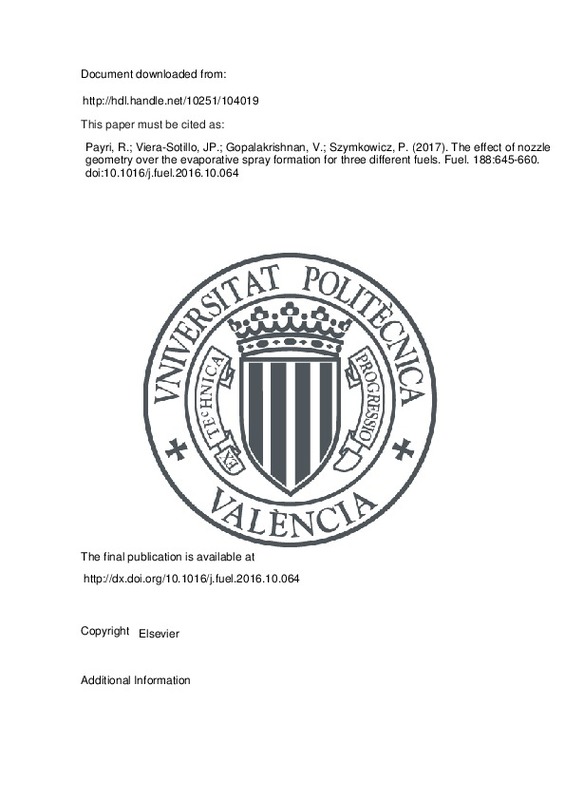JavaScript is disabled for your browser. Some features of this site may not work without it.
Buscar en RiuNet
Listar
Mi cuenta
Estadísticas
Ayuda RiuNet
Admin. UPV
The effect of nozzle geometry over the evaporative spray formation for three different fuels
Mostrar el registro sencillo del ítem
Ficheros en el ítem
| dc.contributor.author | Payri, Raúl
|
es_ES |
| dc.contributor.author | Viera-Sotillo, Juan Pablo
|
es_ES |
| dc.contributor.author | Gopalakrishnan , Venkatesh
|
es_ES |
| dc.contributor.author | Szymkowicz, Patrick
|
es_ES |
| dc.date.accessioned | 2018-06-14T04:33:53Z | |
| dc.date.available | 2018-06-14T04:33:53Z | |
| dc.date.issued | 2017 | es_ES |
| dc.identifier.issn | 0016-2361 | es_ES |
| dc.identifier.uri | http://hdl.handle.net/10251/104019 | |
| dc.description.abstract | [EN] The influence of internal nozzle flow characteristics over the evaporative spray development is studied experimentally for two different nozzle geome-tries and three different fuels. This is a continuation of previous work by the authors where non-evaporative isothermal spray development was stud-ied experimentally for the same nozzle geometries and fuels. Current study reports macroscopic spray characteristics by imaging the liquid and vapor phases of the spray simultaneously using independent cameras and optical techniques. The liquid phase is captured by a fast-pulsed diffused back illumination setup, while the vapor phase is captured by a single-pass Schlieren setup with diaphragm. The nozzle geometries consist of a conical nozzle and a cylindrical nozzle with 8.6 % larger outlet diameter when compared to the conical nozzle. Among the three fuels, two are pure components n-heptane and n-dodecane while the third consists of a three-component surrogate to better represent the physical and chemical properties of diesel fuel. For a fixed ambient density, the liquid penetration is controlled by ambient temperature while the vapor penetration is controlled by injection pressure. The cylindrical nozzle, in spite of higher mass flow rate and momentum flux,shows slower vapor spray tip penetration when compared to the conical noz-zle. Also, the cylindrical nozzle consistently produced shorter liquid lengths. The vapor spray spreading angle is found to be inversely proportional to the spray tip penetration, largely influenced by the nozzle geometry and the am-bient density. n-Heptane spray shows the shortest liquid lengths, followed by n-dodecane and finally the Surrogate. No significant difference in vapor penetration rates was found between fuels, confirming that the vapor spray is controlled by momentum, which is independent of fuel. This was not the case for the non-evaporative isothermal sprays previously studied by the au-thors. Liquid lengths show the expected responses to parametric variations of ambient temperature and density. Two empirical predictive models are presented and utilized to analyze the influence of fuel properties on the liq-uid length. The primary factor controlling the liquid length between fuels is found to be their volatility. Finally, the cylindrical nozzle exhibits larger line-of-sight contour fluctuations in both the liquid and vapor phases, which in turn contributes to the shorter liquid lengths and slower vapor penetration. | es_ES |
| dc.description.sponsorship | This work was sponsored by Ministerio de Economía y Competitividad of the Spanish Government in the frame of the Project “Estudio de la interaccin chorro-pared en condiciones realistas de motor”, Reference TRA2015-67679-c2-1-R. Additionally, the employed nozzles and Diesel surrogate were provided and defined by GM R&D. The authors would like to thank José Enrique Del Rey and María del Carmen Tomás for their collaboration in the setup of the experiments and laboratory work, and Guillermo Miró for his help measuring fuel properties. | |
| dc.language | Inglés | es_ES |
| dc.publisher | Elsevier | es_ES |
| dc.relation.ispartof | Fuel | es_ES |
| dc.rights | Reconocimiento - No comercial - Sin obra derivada (by-nc-nd) | es_ES |
| dc.subject | Macroscopic spray development | es_ES |
| dc.subject | Evaporative spray formation | es_ES |
| dc.subject | Surrogate fuels | es_ES |
| dc.subject | Liquid length | es_ES |
| dc.subject | Vapor penetration | es_ES |
| dc.subject | Spray dispersion | es_ES |
| dc.subject.classification | MAQUINAS Y MOTORES TERMICOS | es_ES |
| dc.title | The effect of nozzle geometry over the evaporative spray formation for three different fuels | es_ES |
| dc.type | Artículo | es_ES |
| dc.identifier.doi | 10.1016/j.fuel.2016.10.064 | es_ES |
| dc.relation.projectID | info:eu-repo/grantAgreement/MINECO//TRA2015-67679-C2-1-R/ES/ESTUDIO DE LA INTERACCION CHORRO-PARED EN CONDICIONES REALISTAS DE MOTOR/ | es_ES |
| dc.rights.accessRights | Abierto | es_ES |
| dc.date.embargoEndDate | 2019-01-15 | es_ES |
| dc.contributor.affiliation | Universitat Politècnica de València. Departamento de Máquinas y Motores Térmicos - Departament de Màquines i Motors Tèrmics | es_ES |
| dc.description.bibliographicCitation | Payri, R.; Viera-Sotillo, JP.; Gopalakrishnan, V.; Szymkowicz, P. (2017). The effect of nozzle geometry over the evaporative spray formation for three different fuels. Fuel. 188:645-660. https://doi.org/10.1016/j.fuel.2016.10.064 | es_ES |
| dc.description.accrualMethod | S | es_ES |
| dc.relation.publisherversion | http://dx.doi.org/10.1016/j.fuel.2016.10.064 | es_ES |
| dc.description.upvformatpinicio | 645 | es_ES |
| dc.description.upvformatpfin | 660 | es_ES |
| dc.type.version | info:eu-repo/semantics/publishedVersion | es_ES |
| dc.description.volume | 188 | es_ES |
| dc.relation.pasarela | S\319508 | es_ES |
| dc.contributor.funder | Ministerio de Economía, Industria y Competitividad | es_ES |







![[Cerrado]](/themes/UPV/images/candado.png)

